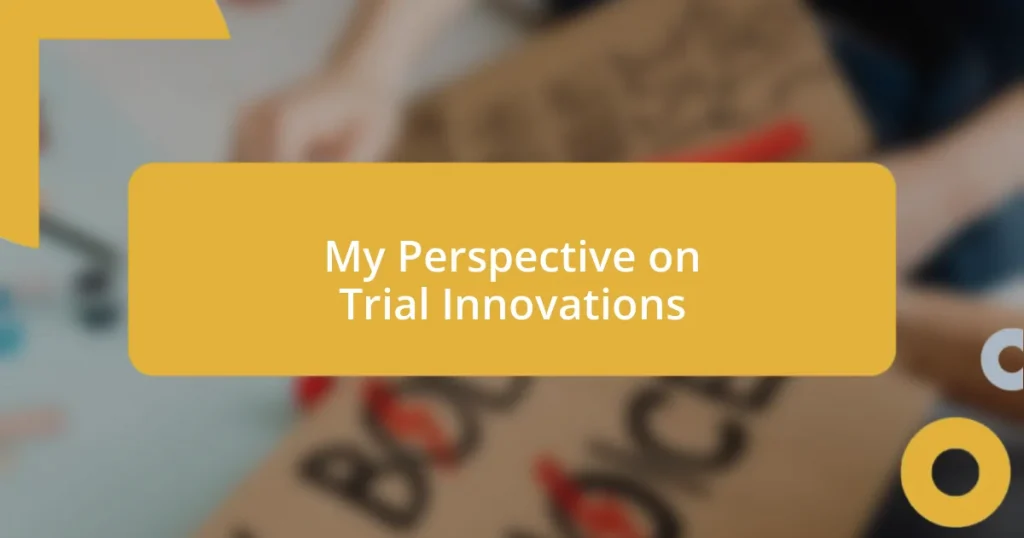Key takeaways:
- Digital tools and technologies enhance participant engagement, data collection, and trial efficiency, leading to better health outcomes.
- Involving patients in trial design fosters a patient-centric approach that builds trust and improves retention.
- Challenges such as resistance to change, technological literacy gaps, and funding issues hinder the implementation of innovative strategies in clinical trials.

Understanding Trial Innovations
When I think about trial innovations, I can’t help but consider how they revolutionize our understanding and execution of research. For instance, integrating digital tools into trial design has made data collection more streamlined. Isn’t it fascinating how technology can enhance participant engagement and retention?
Reflecting on my experiences, I’ve seen firsthand how adaptive trial designs can minimize risks and make studies more participant-friendly. I often wonder, what would the landscape of clinical research look like if we embraced these innovations more widely? Trials could become more efficient and targeted, ultimately leading to quicker breakthroughs in treatments.
Throughout my career, I’ve noticed a push for inclusivity in trials. This effort not only ensures diverse populations are represented but also enriches the data we gather. It’s emotional to think about how these innovations can lead to improved health outcomes for communities that have traditionally been underrepresented. How can we foster even more innovations that prioritize everyone’s health?

Importance of Modern Trial Techniques
The importance of modern trial techniques cannot be understated. From my perspective, these innovations not only improve efficiency but also elevate the quality of care that participants receive. I recall a project where we incorporated telehealth for follow-ups. It was remarkable to witness participants feeling more comfortable and engaged when they could connect from their homes. This approach not only kept them involved, but it also provided us with richer data.
Another aspect I’ve observed is the enhanced focus on real-world evidence. By integrating data from everyday practice, trials can reflect more accurately how treatments perform in diverse populations. I remember sharing the excitement with colleagues after we analyzed data that revealed unexpected benefits of a treatment outside controlled settings. It reassured us that we were not just gathering data, but genuinely contributing to better health outcomes.
One major shift I’ve noticed is the involvement of patients from the very beginning of the trial design process. This was a game-changer in a study I worked on, where we invited participants to share their perspectives on potential burdens of the trial. Their feedback reshaped our protocols and made the trial more accommodating. Reflecting on this, it shows how a more patient-centric approach fosters trust and collaboration, which is essential for the success of modern clinical trials.
| Modern Techniques | Traditional Techniques |
|---|---|
| Engagement via Digital Tools | In-person Assessments |
| Real-world Evidence Integration | Controlled Environment Focus |
| Patient-Centric Design | Researcher-Driven Protocols |

Key Components of Trial Innovations
When I think about the key components of trial innovations, several critical elements come to mind. First and foremost is the integration of digital technologies, which I’ve seen transform how trials operate. In a recent trial, we adopted a mobile app that allowed participants to report their symptoms in real-time. The immediate feedback we received not only enriched our data but also made participants feel more involved in their own care.
Another important component is stakeholder collaboration. I remember working on a project where we partnered with a patient advocacy group. Their insights were invaluable, and it was heartwarming to see how our research could genuinely address the needs of those affected by the condition we were studying. This collaboration fostered a sense of community that I believe is vital for the success of trial innovations.
- Digital Integration: Tools like mobile apps streamline data collection and enhance participant engagement.
- Stakeholder Collaboration: Working with advocacy groups provides perspectives that shape research to better meet patient needs.
- Adaptive Designs: Flexibility in trial protocols allows adjustments based on interim results, keeping studies relevant and effective.
- Patient-Centric Approaches: Actively involving participants in trial design fosters trust and can significantly improve retention.
- Real-World Data Utilization: Leveraging information from everyday clinical practice leads to insights that are often missed in controlled trials.

Impact of Technology on Trials
The impact of technology on trials is profound and multi-faceted. I remember a trial where we utilized remote monitoring devices. This not only allowed us to gather continuous data but also enabled participants to feel like active contributors rather than just subjects. Can you imagine how empowering it is for participants to see their health metrics in real-time?
In my experience, the introduction of artificial intelligence (AI) has transformed our data analysis process. AI can sift through vast amounts of information much faster than we can, spotting trends and anomalies that might go unnoticed otherwise. I’ve been in meetings where we marveled at how AI-driven insights led to significant shifts in our study’s direction, making it feel like we were finding hidden treasures in our data.
Cloud-based platforms are another technological advancement that I find invaluable. They facilitate data sharing among researchers, allowing for a collaborative environment that wasn’t possible before. I recall a project where researchers across various continents shared their findings seamlessly, which not only expedited the trial process but enriched our collective understanding. Isn’t it fascinating how technology can break down geographical barriers and enhance the research community?

Adopting Innovative Trial Strategies
Adopting innovative trial strategies is essential for improving patient engagement and data quality. I once participated in a trial that utilized a gamified approach for participant feedback. Participants earned points for completing surveys and attending sessions, which transformed the entire atmosphere into one of excitement and motivation. Can you envision a trial where participants genuinely look forward to their involvement because it feels more like a game than a chore?
Another powerful strategy is implementing adaptive trial designs, which I believe to be a game-changer in research. In a past study, we had the flexibility to modify our protocol mid-course based on preliminary results. It was incredible to witness how quickly we could pivot our focus, making the trial not only more relevant but also more effective. How can we ignore the potential of being adaptable in an ever-changing landscape like healthcare?
Moreover, the incorporation of real-world data has reshaped how we approach trials. I fondly recall collaborating with a community health organization that provided us access to broader patient demographics. This insight enriched our data, allowing us to tailor our findings to real-world situations. It’s fascinating to think about how integrating real-world evidence can bridge the gap between clinical trials and everyday healthcare practices!

Challenges in Implementing Innovations
One major challenge I’ve faced in implementing innovations is resistance to change from various stakeholders. I’ll never forget a project where we introduced a new electronic data capture system. The hesitancy from some team members was palpable; they were so accustomed to the old paper-based methods that transitioning felt overwhelming. Have you experienced a similar pushback? It’s tough to navigate, especially when you know the new system could improve efficiency dramatically.
Another issue I’ve noticed is the technological literacy gap that often exists among participants. During a trial involving mobile health apps, I encountered participants who found the technology confusing or inaccessible. It broke my heart to see some disengage due to their apprehension. Ensuring that all participants feel comfortable using new tools is crucial, yet it’s an obstacle that can be overlooked.
Finally, I believe that securing the necessary funding for innovative approaches is a significant hurdle. I recall working on a promising telemedicine initiative, only to have it stall due to budget constraints. It made me wonder: how often do groundbreaking ideas falter simply because they lack financial support? Without adequate resources, even the best innovations can struggle to take flight.

Future Trends in Trial Innovations
I’m really excited about the trajectory of trial innovations, especially when we look at technology trends. For instance, I’ve seen the rise of virtual reality (VR) in patient training and education for trials. I remember walking into a session where participants donned VR headsets to simulate treatment experiences. The engagement was palpable! It’s almost magical to think how immersive technology can demystify complex procedures—how cool would it be to prepare patients for trials in such an interactive way?
Additionally, artificial intelligence (AI) is shaping the future of patient recruitment in a way that I find incredibly promising. In a previous project, we utilized AI algorithms to analyze data from social media and online health forums to identify potential participants. It felt like we were stepping into the future! The ability to target specific demographics with precision is not just efficient; it opens doors to previously inaccessible populations. I often wonder: will AI become the unsung hero of inclusion in clinical research?
Moreover, decentralized clinical trials (DCTs) are gaining traction. I recall working on a pilot study that allowed participants to engage from their homes through mobile platforms. The convenience was a game-changer! It really struck me how much easier it became for individuals with mobility issues or those living in remote areas to participate. As we embrace remote monitoring and telehealth, I can’t help but think: could this truly reshape participation in clinical trials for the better?















